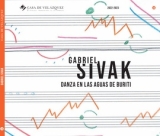Mit der Suite Capoeira eröffnet der französisch-argentinische Komponist Gabriel Sivak sein Album. Die viersätzige Suite enthält rhythmisch-tänzerische und sehr lyrisch-melancholische Musik mit brasilianischen Einflüssen, die vom Quatuor Voce sehr stimmungsvoll interpretiert wird.
Descaminos für Cello und Orchester bezieht sich auf das spanische Wort ‘descaminar », was so viel bedeutet wie « den vorgezeichneten Weg verlassen ». Es sei ein Zeugnis von all den musikalischen ‘Umleitungen’, die er genommen habe, bis er Komponist wurde. Entsprechend vielseitig ist das Werk, mal lyrisch, mal virtuos, und mit ganz aparten Klangtexturen.
Patrick Langot spielt ausgezeichnet und spannungsvoll, gut begleitet vom Orchestre de Lutetia unter Alejandro Sandler.
Mit Kathakali, gespielt von David Kadouch am Klavier, sind wir in Indien und dem gleichnamigen Tanztheater angekommen. Kadouch meistert das polyrhytmische Stück sehr gut und gibt der Musik einen guten Teil Exotik.
Das Vokalensemble Musicatreize singt ‘Uray Puriq Mayun’ auf einen Text in der indigenen Andensprache Ketschua und gibt diesem Song mit viel gestalterischer Spontaneität einen sehr authentischen Charakter.
‘4 Esencias’ ist ebenfalls ein Vokalstück, und es beschäftigt sich mit den vier Elementen, Wasser, Feuer, Erde und Luft. Die Musik ist modern und gleichzeitig geprägt von einem gewissen Primitivismus. Musicatreize gelingt eine spannende und attraktive Interpretation dieser anspruchsvollen Komposition.
Das vom Orchestre du Pays de la Loire unter Manuel Hernandez Silva gespielte Lagrimas de Tahuari beendet dieses vielseitige Programm
Das Stück ist inspiriert von einer Reise in den Amazonas, wo der Komponist im Jahre 2022 bei den Kuikuros-Indianern wohnte. Er beschreibt die Komposition so: « Die Ouvertüre Mata adentro erinnert an das Erstaunen beim Betreten des Waldes. Huka-Huka ist von einer von den Indianer praktizierten Kampfkunst inspiriert. Aguas de Buriti suggeriert das Gefühl des Eintauchens beim Schwimmen in der Natur. Der Satz Danse et polyrythmie (Tanz und Polyrhythmik) ist von einem Naturbild inspiriert. Das Leben im Wald bringt uns dazu, rhythmische Muster unter den Bäumen, Insekten und Vögeln zu hören. » Kuikuros ist ein Satz, der in direktem Zusammenhang mit der Musik der Ethnien des Xingu Parks steht. Die Musik ist reich, farbig und vermittelt unmittelbar die Atmosphäre, die Sivak inspirierte.
Wir haben es somit hier mit einem guten und aussagekräftigen Porträt eines Komponisten zu tun, der seine eigene Sprache gefunden hat.
The French-Argentine composer Gabriel Sivak opens his album with the Suite Capoeira. The four-movement suite contains rhythmic, dance-like and very lyrical, melancholic music with Brazilian influences, which is interpreted very atmospherically by Quatuor Voce.
Descaminos for cello and orchestra refers to the Spanish word « descaminar », which means « to leave the beaten path ». It is a testimony to all the musical « detours » he took to become a composer. The work is correspondingly varied, sometimes lyrical, sometimes virtuosic, and with very distinctive sound textures.
Patrick Langot’s playing is excellent and exciting, well accompanied by the Orchestre de Lutetia under Alejandro Sandler.
With Kathakali, played by David Kadouch on the piano, we have arrived in India and the dance theater of the same name. Kadouch masters the polyrhythmic piece very well and gives the music a good dose of exoticism.
The vocal ensemble Musicatreize sings ‘Uray Puriq Mayun’ to a text in the indigenous Andean language Ketchua, giving this song a very authentic character with a lot of creative spontaneity.
4 Esencias’ is also a vocal piece and deals with the four elements: water, fire, earth and air. The music is modern and at the same time characterized by a certain primitivism. Musicatreize succeeds in creating an exciting and attractive interpretation of this challenging composition.
Lagrimas de Tahuari, performed by the Orchestre du Pays de la Loire conducted by Manuel Hernandez Silva, concludes this varied program.
The piece was inspired by a trip to the Amazon, where the composer stayed with the Kuikuros Indians in 2022. He describes the composition as follows: « The overture Mata adentro evokes the astonishment of entering the forest. Huka-Huka is inspired by a martial art practiced by the Indians. Aguas de Buriti suggests the feeling of immersion when swimming in nature. The movement Danse et Polyrythmie (Dance and Polyrhythm) is inspired by an image of nature. Life in the forest makes us hear rhythmic patterns among the trees, insects and birds. » Kuikuros is a phrase directly related to the music of the ethnic groups of the Xingu Park. The music is rich, colorful and immediately conveys the atmosphere that inspired Sivak.
What we have here is a good and meaningful portrait of a composer who has found his own language.






















